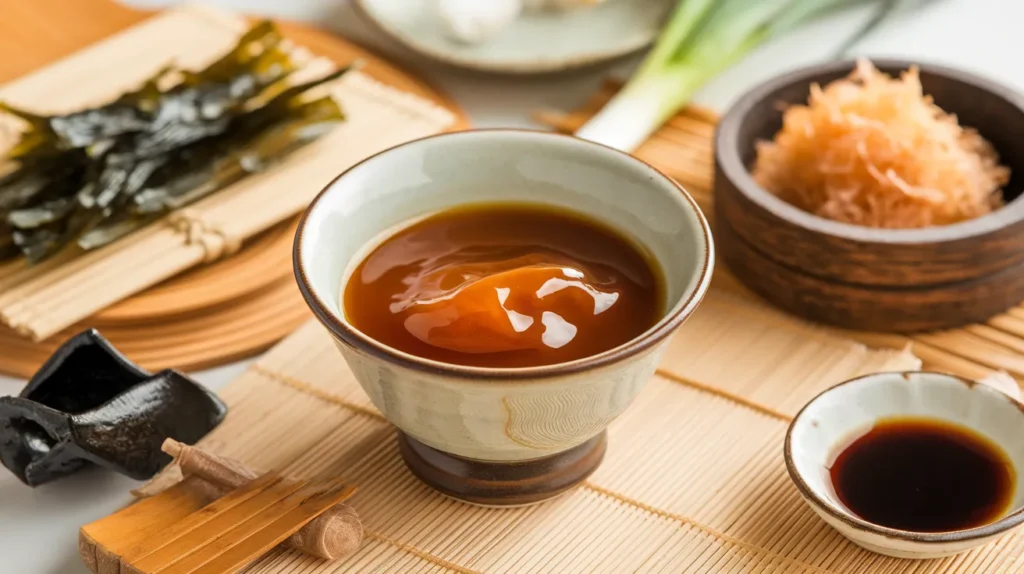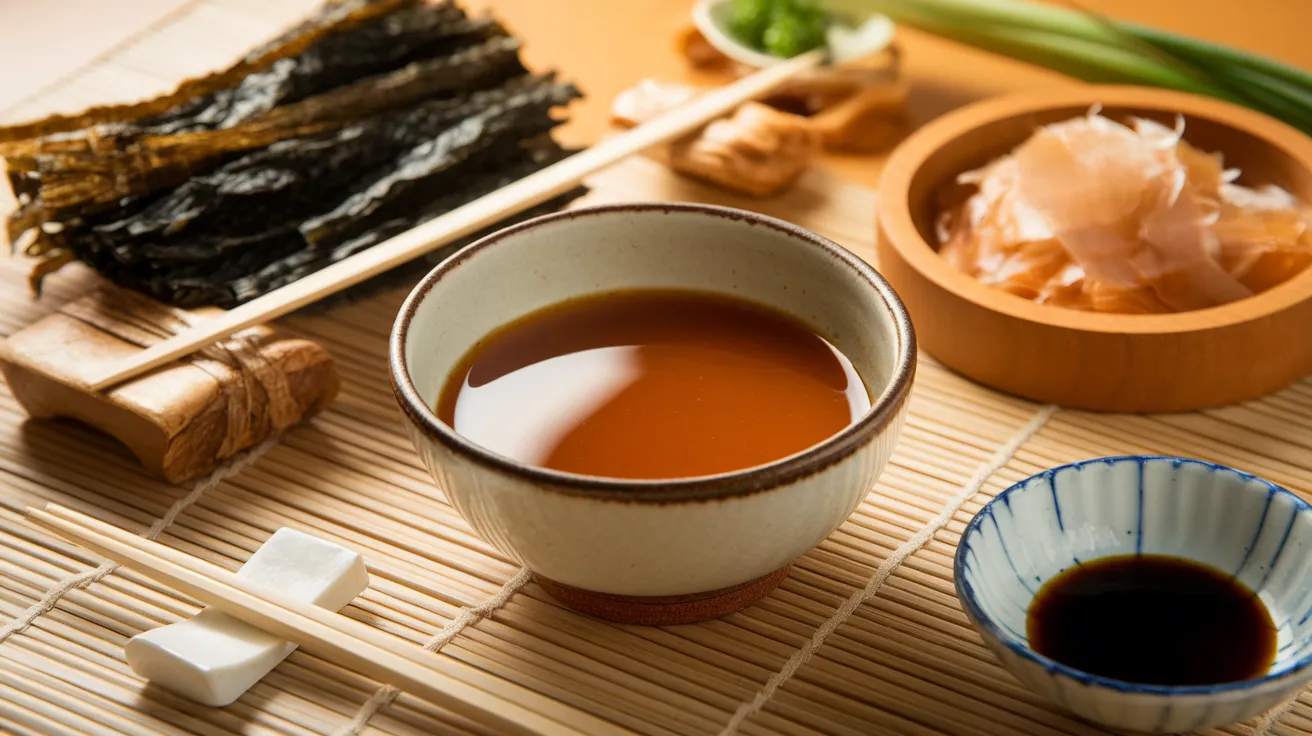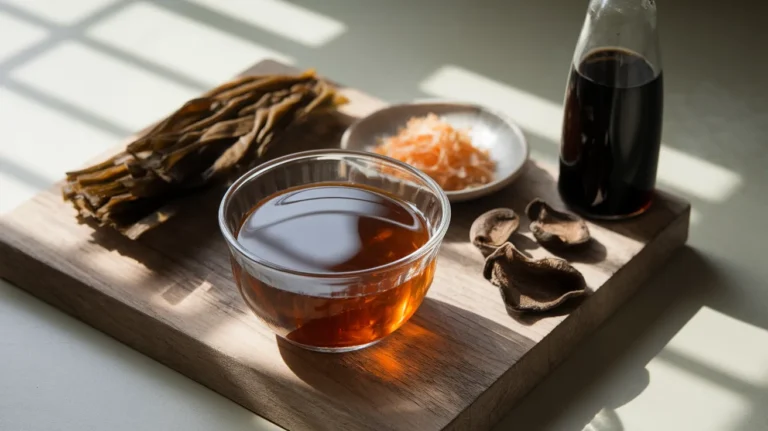This savory dashi sauce brings the deep, umami-rich flavors of Japanese cuisine right to your kitchen. Made with just a few simple ingredients, this versatile dashi sauce elevates everything from grilled vegetables to steamed rice. Perfect for beginners who want to explore authentic Japanese flavors, this savory dashi sauce recipe creates a complex, restaurant-quality condiment that’s surprisingly easy to master at home.
SERVES: 4 | PREP: 15 MIN | COOK: 20 MIN | TOTAL: 35 MIN
Ingredients
Base Ingredients
| Ingredient | Amount | Notes |
|---|---|---|
| Kombu seaweed | 2 pieces (4 inches each) | Dried kelp, found in Asian markets |
| Bonito flakes | 1 cup packed | Also called katsuobushi |
| Water | 4 cups | Filtered works best |
Sauce Components
| Ingredient | Amount | Purpose |
|---|---|---|
| Soy sauce | 3 tablespoons | Adds saltiness and color |
| Mirin | 2 tablespoons | Sweet rice wine for balance |
| Rice vinegar | 1 tablespoon | Brightens the flavor |
| Sugar | 1 teaspoon | Rounds out the taste |
Step-by-Step Instructions
Phase 1: Creating the Dashi Base (15 minutes)
Step 1: Fill a medium saucepan with 4 cups of cold, filtered water. Add the two pieces of kombu seaweed and let them soak for 10 minutes. This soaking step is crucial because it allows the kombu to release its natural glutamates slowly, creating that signature umami depth.
Step 2: Place the saucepan over medium-low heat and slowly bring the water to a gentle simmer. Watch carefully – you’ll see tiny bubbles forming around the edges first. This should take about 8-10 minutes. Never let it boil rapidly as this will make your dashi bitter and cloudy.
Step 3: Just before the water reaches a rolling boil, remove the kombu pieces with tongs or a slotted spoon. You’ll notice the water has turned slightly golden and smells oceanic – that’s perfect! Save the kombu for another use if desired.
Step 4: Immediately add the packed cup of bonito flakes to the hot water. Don’t stir! Let them dance and swirl naturally in the liquid. The flakes will initially float, then slowly begin to sink as they release their smoky flavor.
Step 5: Let the bonito flakes steep for exactly 3 minutes. Set a timer – this timing is critical for balanced flavor. Too short and you’ll miss the depth; too long and it becomes overpowering.
Step 6: Strain the dashi through a fine-mesh strainer lined with cheesecloth or a coffee filter into a clean bowl. Press gently on the bonito flakes to extract maximum liquid, but don’t squeeze hard. You should have about 3½ cups of clear, amber-colored dashi.
Phase 2: Building Your Savory Dashi Sauce (5 minutes)
Step 7: Measure out 2 cups of your fresh dashi and pour it into a clean saucepan. Reserve the remaining dashi for other uses – it keeps in the refrigerator for up to 3 days.
Step 8: Add the 3 tablespoons of soy sauce to the dashi and stir gently. Notice how the color deepens to a rich caramel brown. The soy sauce provides the essential saltiness that makes this a true sauce rather than just broth.
Step 9: Whisk in the 2 tablespoons of mirin. This sweet rice wine adds complexity and helps balance the saltiness. If you don’t have mirin, substitute with 1 tablespoon sugar mixed with 1 tablespoon sake or dry sherry.
Step 10: Add the 1 tablespoon of rice vinegar and 1 teaspoon of sugar. Whisk everything together until the sugar completely dissolves. Taste and adjust – the sauce should be savory with subtle sweet notes and a bright finish.
Phase 3: Final Cooking and Consistency (5 minutes)
Step 11: Bring the sauce mixture to a gentle simmer over medium heat. You’ll see small bubbles breaking the surface – this is perfect. Simmer for 3-4 minutes to allow all flavors to meld and the sauce to reduce slightly.
Step 12: Remove from heat and let cool for 2 minutes. The sauce will thicken slightly as it cools. For a thicker consistency, simmer an additional 2-3 minutes until it coats the back of a spoon.
Step 13: Taste your finished savory dashi sauce and make final adjustments. Add more soy sauce for saltiness, mirin for sweetness, or vinegar for brightness. The perfect balance should hit all your taste buds harmoniously.
Chef’s Notes
Kombu Quality Matters: Look for thick, dark green kombu with a white powdery coating – that’s natural glutamate crystals, not mold! Don’t wash it off; it’s pure umami gold that makes your savory dashi sauce exceptional.
Bonito Flake Freshness: Fresh bonito flakes should smell slightly smoky and oceanic, not fishy. Store them in an airtight container after opening to maintain their delicate flavor profile.
Temperature Control: The key to clear, clean-tasting dashi is gentle heat. Boiling creates cloudiness and bitter flavors that will overpower your finished savory dashi sauce.
Make-Ahead Strategy: Double the dashi base recipe and freeze portions in ice cube trays. You’ll always have the foundation ready for quick savory dashi sauce preparation.
Nutrition Information (Per 2-tablespoon serving)
- Calories: 15
- Protein: 1g
- Carbohydrates: 3g
- Fat: 0g
- Sodium: 340mg
Creative Variations
Spicy Dashi Sauce: Add 1 teaspoon of chili oil or ½ teaspoon of shichimi togarashi for heat. This variation pairs beautifully with grilled meats and complements other Japanese condiments like oroshi sauce for a complete flavor profile.
Citrus Dashi Sauce: Replace rice vinegar with fresh yuzu or lemon juice for a bright, zesty twist. Perfect for seafood and light vegetables.
Rich Mushroom Dashi: Add 2 dried shiitake mushrooms during the kombu soaking stage for deeper earthy flavors. This creates an incredibly complex sauce that rivals restaurant versions.
Creamy Dashi Sauce: Whisk in 1 tablespoon of tahini or cashew butter after cooling for a unique fusion approach. This variation works wonderfully alongside bold flavors like mentaiko sauce in modern Japanese cooking.
Storage & Reheating
Refrigerator Storage: Your savory dashi sauce keeps fresh in an airtight container for up to 5 days. Store in glass jars to prevent any metallic taste transfer.
Freezing Instructions: Freeze in ice cube trays for convenient portion control. Frozen cubes last up to 3 months and thaw quickly for instant use.
Reheating Guidelines: Warm gently in a small saucepan over low heat. Never microwave at high power as it can break the delicate flavor balance. Stir occasionally and taste before serving.

Troubleshooting Guide
Problem: Cloudy, murky dashi
Solution: Your water got too hot too fast. Next time, heat more gradually and remove kombu before boiling. Strain through coffee filters for clearer results.
Problem: Bitter or overpowering taste
Solution: Either the kombu or bonito steeped too long, or the water boiled. Start fresh and watch your timing more carefully. Less is often more with dashi.
Problem: Too salty or one-dimensional
Solution: Balance with more mirin or a touch of sugar. The savory dashi sauce should have complexity, not just saltiness.
Problem: Sauce separates or looks oily
Solution: This happens when ingredients aren’t properly dissolved. Reheat gently while whisking to re-emulsify all components.
Problem: Lacks depth and umami punch
Solution: Your kombu or bonito flakes may be old. Invest in high-quality ingredients – they make all the difference in authentic savory dashi sauce.
Equipment Essentials
- Medium saucepan (3-quart capacity)
- Fine-mesh strainer
- Cheesecloth or coffee filters
- Whisk for smooth blending
- Timer for precise steeping
- Glass storage containers
Shopping List
Asian Market Section
- Kombu seaweed (dried kelp)
- Bonito flakes (katsuobushi)
- Mirin (sweet rice wine)
Condiment Aisle
- Soy sauce (Japanese brands preferred)
- Rice vinegar
- Granulated sugar
Pantry Items
- Filtered water
Success Secrets
1. Start with cold water when making dashi – hot water extracts bitter compounds too quickly and ruins the delicate balance of your savory dashi sauce.
2. Never squeeze the bonito flakes when straining – gentle pressing extracts flavor while aggressive squeezing adds unwanted bitterness.
3. Taste and adjust in small increments – it’s easier to add more seasoning than to fix an over-seasoned sauce.
4. Use your savory dashi sauce within a week for peak flavor, though it’s safe longer when properly stored.
5. Warm the sauce slightly before serving to awaken all the complex flavors and aromas that make this condiment so special.




